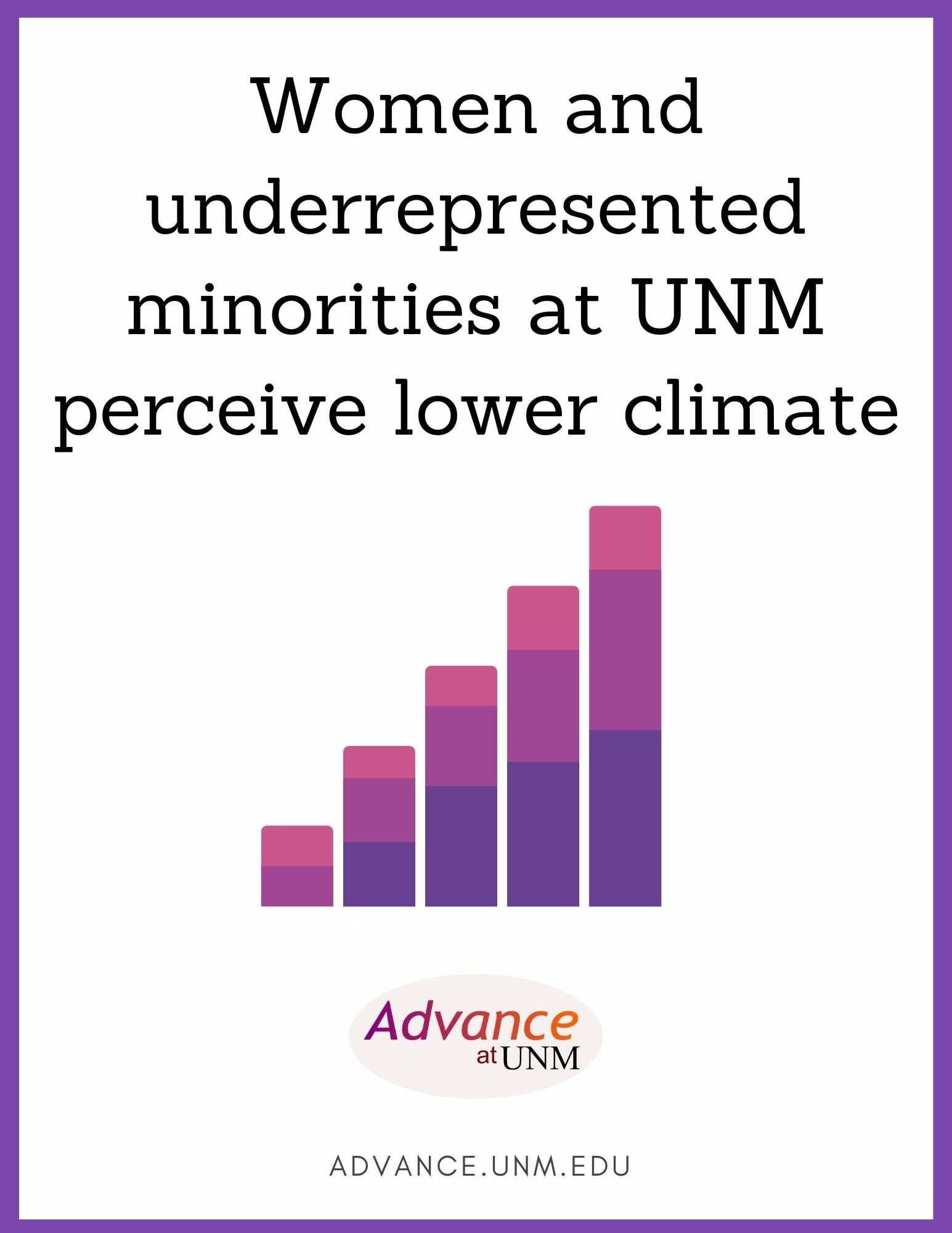Women and underrepresented minorities at UNM perceive lower climate
The Advance at UNM Social Science Research Team (SSRT) is working towards publishing journal articles about three different University of New Mexico campus climate studies.
Through two of the three studies, the team found that women and underrepresented minority (URM) faculty in STEM fields perceive an overall lower climate than white men in STEM fields.
The SSRT is part of Advance at UNM, a five-year grant aiming to support women and minority faculty.
“I really hope that climate perceptions and equity improve so that we don’t see as many discrepancies in faculty’s experiences,” said Lisa Marchiondo, member of the Advance at UNM SSRT and an assistant professor at Anderson School of Management. “Even if UNM does achieve gender and racial equity in terms of numbers of women and URM faculty, we don’t want these underrepresented groups to report poorer interpersonal experiences.”

According to the National Science Foundation, a STEM field includes social sciences, as seen in the UNM College of Arts and Sciences, as well as the traditional hard sciences such as engineering or biology.
In the other study, led by Marchiondo, researchers found that leaders’ attitudes towards diversity more strongly influence male faculty members’ perceptions of bias, as opposed to female faculty. Marchiondo said causation cannot be established in this study, but rather a correlation was established between leaders’ diversity attitudes and perceived campus bias by male faculty.
“It is not that women don’t think bias is problematic. On average, (women) are already really endorsing (diversity),” Marchiondo said. “Whereas, with men, it appears as though their perceptions are shaped more by leaders’ pro-diversity attitudes. When men worked under a leader who had strong pro-diversity attitudes, they were much more likely to endorse diversity initiatives on campus.”
Out of the UNM faculty surveyed, 70 were university leaders — deans, chairs, etc.— and 294 were non-leadership faculty.
Marchiondo said other research suggests that alignment between leaders’ and followers’ attitudes is crucial to the success of any kind of diversity initiative. Trust in leadership also plays a factor in the success of diversity initiatives.
“The leadership research shows that when followers don’t trust their leaders, it leads to a whole host of negative outcomes,” Marchiondo said. “So, finding ways to build trust is important, and a lot of trust-building is rooted in good communication.”
The two other studies addressed climate perceptions of the University by both women and URM faculty.
Kamilla Venner, a member of the SSRT and assistant professor of psychology, led the study focused on STEM women’s campus climate perceptions.
The study identified four meditors that help explain STEM women’s lower perceptions of campus climate. These mediators are discrimination awareness, seeing bias as problematic, lower University diversity values, and lack of trust in University leadership.
“By identifying these mediators, we’re hoping to help give leaders tools they can use to improve climate perceptions,” Marchiondo said.
Another takeaway from this study, according to Marchiondo, is that men in STEM fields have significantly different perceptions, compared to women in STEM fields as well as compared to men and women in non-STEM fields.
“Men in STEM are significantly more likely to report that bias and discrimination are less problematic at UNM, that they trust leadership, and that they believe leaders value diversity on campus” Marchiondo said. “Whereas the other three groups — women in STEM, as well as men and women in non-STEM — rate these variables significantly differently.”
Marchiondo added that these groups are more likely to have greater reports of bias/discrimination, less trust in leadership and lower perceptions that the University values diversity.

“STEM fields tend to be male-dominated. Drawing on research on diversity and inclusion, it’s possible that STEM men might not be as aware of bias or discrimination, due to homogeneity in their fields, which could ultimately shape their perceptions of mistreatment or other inequities,” Marchiondo said.
Steven Verney, a member of the SSRT and associate professor of psychology, led the study focusing on the climate perceptions of URM faculty.
Like women STEM faculty, URM faculty also report a lower overall climate at the University. However, URM faculty identify slightly different reasons or mediators for their overall lower climate perceptions. Where STEM women identify trust in leadership as a reason for their climate dissatisfaction, URM faculty report work-life imbalance as an explanation for theirs.
Marchiondo said this does not imply that work-life balance is unimportant to women faculty; it has arisen as a focal issue to URM faculty.

“The more that university administrators can help faculty, especially URM faculty, achieve work-family balance, the more it will boost faculty members’ climate perceptions,” Marchiondo said.
Of the three studies, one is under review at a peer-reviewed organizational studies journal, and the other two are in the process of being written for submission to peer-reviewed journals.
While this is not the first time an analysis of campus climate for women and URM faculty has been conducted, Marchiondo said that this is one of the first times solutions to address lower climate ratings have been proposed to university leadership.
“This is one of the first times that scholars are going beyond women and URM faculty’s lower climate perceptions and addressing what administrators can do about it” Marchiondo said. “The team is trying to be much more practically-minded and problem-solving, beyond just documenting the problem.”

